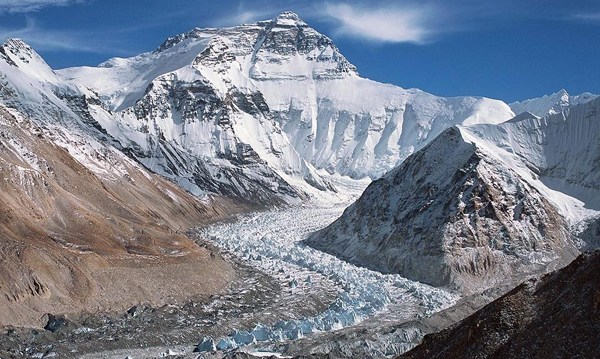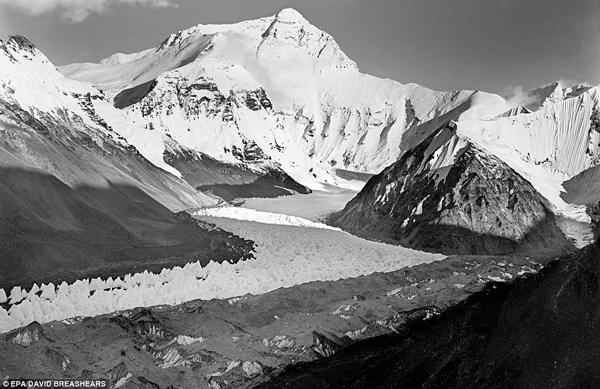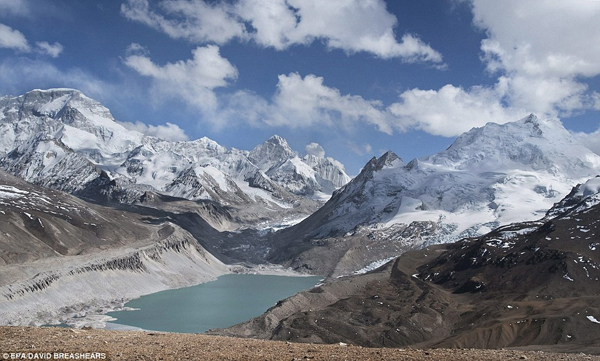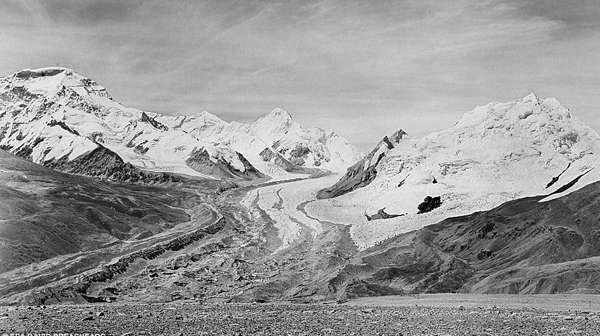US photographer, filmmaker and mountaineer David Breashears has put together a collection of works to compare his contemporary images with historical photographs taken over the past century,aiming at comparing changes in the landscape and show the dramatic glacial loss that has taken place in the Greater Himalayan region.

Roadway of ice and snow: This striking image taken by David Breashears' team of mountaineers shows snow peaks like cake icing leading to the base of the Rongbuk Glacier in the Himalayan mountains. It was inspired by archived photographs taken 80 years ago.

White out: This photograph shows the main Rongbuk Glacier in the Himalayan mountains, Tibet as it was in 1921, covered in snow and ice and in sharp contrast to the landscape today.
Mr Breashears who is also executive director of Tibet-based NGO GlacierWorks, led eight expeditions to the region between 2007 and 2010, in an effort to retrace the steps of pioneering alpine photographers and explorers from the 1920s such as Major E.O. Wheeler, George Mallory, and Vittorio Sella.
A team from GlacierWorks made eight expeditions over a period of three years in an attempt to recapture new images that match the earliest photographic records of the breathtaking glacial vistas.

Snow but mostly rock: The team's image shows the Kyetrak Glacier in the Himalayan mountain range in Tibet and clearly illustrates the different conditions at altitude compared with the area more than 80 years ago.

Great tracts of snow: A black and white photograph of the same region in Tibet and dated from 1921 reveals just how much the region has changed and what the impact has been of global warming on the area.
Breashears told People & Planet magazine: “These then-and-now pictures have a powerful effect on the viewer, one that I hope will bring home the reality — and serious consequences — of climate change.
"Gazing at Italian photographer Vittorio Sella's 1899 picture of the Jannu Glacier in Nepal — a huge ice tongue filling a valley — and then comparing it to my 2009 photo, in which the glacier has disappeared, creates a profound sense of unease."
An RGS spokesman told Amateur Photographer magazine that Mr Breashears has 'recorded losses and changes to glaciers that are otherwise inaccessible to all but the most skilled climbers, thereby providing an invaluable record for their future study'.
Breashears said that the melt rate of glaciers varies widely.
He said: "In the East and Central Himalaya where precipitation comes from the summer monsoon the glaciers show a tremendous loss, with many new lakes.
"Further West there is less melt and greater mass. In the Karakoram, where there is just precipitation in the winter, the glaciers are in better shape. But more work is needed to fully understand what is happening."

Wondrous sight: This contemporary image of the Kyetrak Glacier in the Himalayan mountains in Tibet shows how global warming has created a lake in the mountain range.

Climate change writ large: An historical photograph of the same Tibetan glacier reveals the scale and impact climate change has had on the region.
Breashers said the photographs provide a benchmark for scientists in similar latitudes of the world.
"We can extrapolate future trends from these images," he added "but reports from the field already show that in some years from now, reduced glacier flow will have serious consequences in the dry season.
"This seasonal flow is crucial for farmers and the wider ecosystem. The full implications reveal themselves over time".
